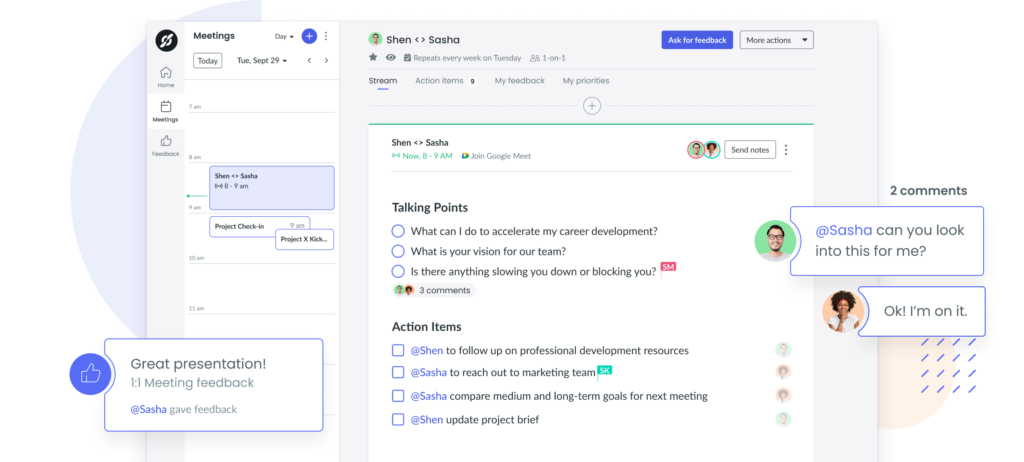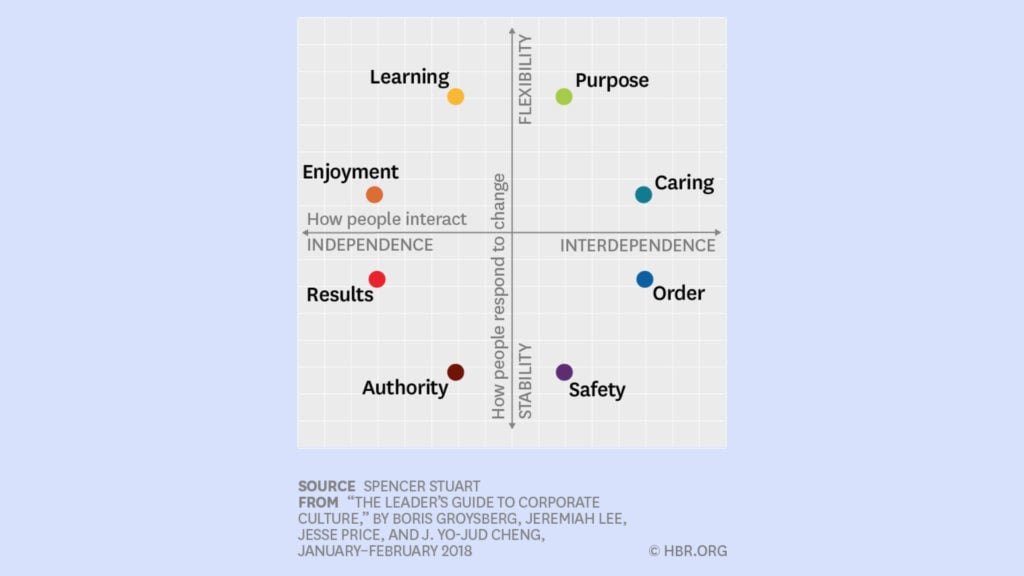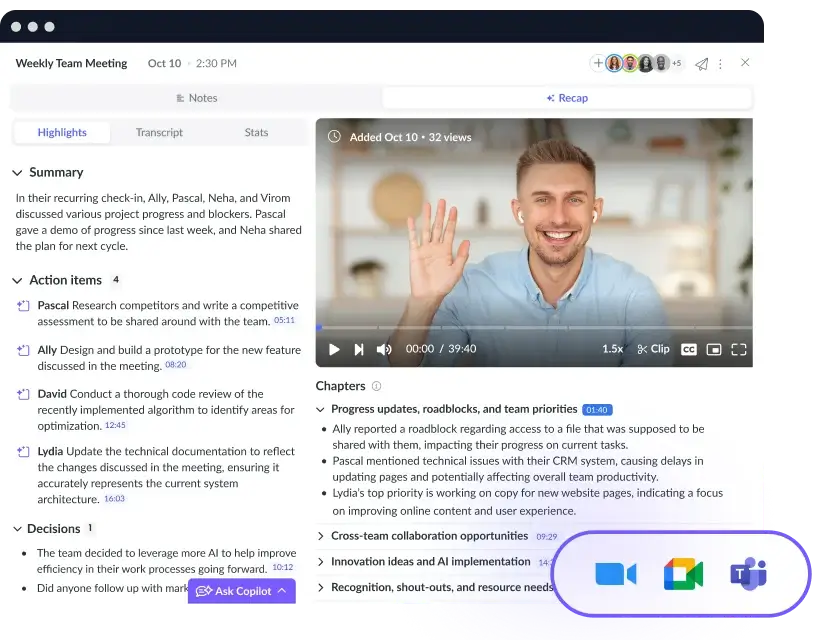8 Types of Company Culture [with Examples]
Company culture can be defined as the set of values, attitudes, and behaviours that characterize an organization. Learn about the different types of culture and identify your own.
Culture eats strategy for breakfast.
That’s a common phrase originated by management expert Peter Drucker, and made famous by Mark Fields, President at Ford.
The truth is, even the best plans and strategies can be derailed by toxic or unhealthy company cultures.
In order to help you build an inspiring and thriving culture, the Fellow team has compiled some important definitions, culture types, and expert opinions in this post.
Keep scrolling to learn more about the 8 different types of cultures and identify which one is yours:
What is company culture?
Company culture can be defined as the set of core values and attitudes that characterize a company or organization. It determines the behaviours that are encouraged (or discouraged) within a group of people, and who is hired, fired, and promoted within the organization.
As Netflix’s CEO, Reed Hastings argues in the company’s culture memo:
“The actual company values, as opposed to the nice-sounding values, are shown by who gets rewarded, promoted, or let go.”
One common misconception that leaders have about company culture is that culture is tied to company benefits such as free lunches and ping pong tables. As Reed Hastings explains, these things might help retain some employees, but do not determine your company culture.
“Great workplace is not espresso, lush benefits, sushi lunches, grand parties, or nice offices. We do some of these things, but only if they are efficient at attracting and retaining stunning colleagues,” says Hastings. “We particularly value nine behaviours and skills in our colleagues, meaning we hire and promote people who demonstrate these nine.”
If you’re curious about Netflix’s nine cultural behaviours, they are judgement, communication, impact, curiosity, innovation, courage, passion, honesty, and selflessness.
What makes Netflix’s company culture so unique is that they rely on these core values to make important decisions, have career development conversations, and share constructive feedback.
Now that you have a clear understanding of what company culture means (and how companies such as Netflix put it into practice), let’s talk about eight different types of company culture that exist across different industries.

Boost company culture
Having regular 1:1’s will improve workplace culture by creating better relationships and meaningful conversations. Try Fellow now!

What are the 8 types of company culture?
In a study published in the Harvard Business Review, culture experts Boris Groysberg, Jeremiah Lee, Jesse Price, and J. Yo-Jud Cheng found that eight characteristics emerge when you look at culture from two different dimensions:
- How people interact (independence to interdependence)
- People’s response to change (flexibility to stability)

“By applying this fundamental insight about the dimensions of people interactions and response to change, we have identified eight styles that apply to both organizational cultures and individual leaders,” says the study. “Each style has advantages and disadvantages, and no style is inherently better than another. An organizational culture can be defined by the absolute and relative strengths of each of the eight and by the degree of employee agreement about which styles characterize the organization.”
Here are the eight types of company culture and real-life examples of each workplace environment shared by Groysberg, Lee, Price, and Cheng in their study:
- Caring workspaces
- Purpose-driven cultures
- Learning cultures
- Playful work environments
- Results-oriented cultures
- Authority cultures
- Safe and risk-conscious cultures
- Structured and methodical work environments
1 Caring workplaces
Caring cultures are collaborative and welcoming. They focus on mutual trust and relationship-building between teammates. These cultures encourage cross-functional collaboration where people with different skill sets support one another.
- 63% of companies in the sample ranked this style of culture first or second to describe their organizational culture.
- Example: Walt Disney Company
According to the HBR study, Disney exemplifies the values and characteristics of a caring culture. As Bob Iger, Chairman and former CEO of the Walt Disney Company wrote in his book, The Ride of a Lifetime:
“Strong leadership embodies the fair and decent treatment of people…Nothing is worse to an organization than a culture of fear.”
– Robert Iger
2 Purpose-driven cultures
Work environments that emphasize purpose put a lot of emphasis on altruism and contributing to the greater good. In these types of cultures, employees are united by their passion for the company mission, which is usually focused on sustainability and supporting global communities.
- 9% of companies have a highly purpose-oriented culture, according to the HBR study.
- Example: Whole Foods
According to John Mackey, founder and CEO at Whole Foods, businesses have a much broader positive impact when they are based on a purpose that goes beyond generating profits and creating value for shareholders.
“Most of the greatest companies in the world also have great purposes….Having a deeper, more transcendent purpose is highly energizing for all of the various interdependent stakeholders.”
– John Mackey
3 Learning cultures
Cultures that value learning also put a high focus on creativity, innovation, and exploration. These companies encourage experimentation and brainstorming, as well as a deep sense of curiosity in employees.
- 7% of organizations rank this inventive style highly, according to the study.
- Example: Tesla
According to the HBR study, Tesla is an example of a learning (or innovative) culture, as Elon Musk (CEO and co-founder) invites employees to be as imaginative as possible:
“Failure is an option here. If things are not failing, you are not innovating.”
– Elon Musk
4 Playful work environments
Companies with a playful culture are characterized by high morale, employee engagement, and fun. In playful work environments, leaders emphasize spontaneity and a sense of humour.
- Only 2% of companies rank enjoyment at the top of their cultural profile.
- Example: Zappos
According to Tony Hsieh, CEO at Zappos, one of the company’s core values is “create fun and a little weirdness.”
“We’ve actually passed on a lot of smart, talented people that we know can make an immediate impact on our top or bottom line but if they’re not good for our culture then we won’t hire them for that reason alone.”
– Tony Hsieh
5 Results-oriented cultures
A result driven culture focuses on goals and results. These companies are outcome-oriented and put a high emphasis on winning. Leaders in these cultures tend to focus on employee performance and drive.
- This style is shared by 89% of companies, according to HBR.
- Example: GSK
According to the HBR study, GlaxoSmithKline (GSK) exemplifies the type of workplace culture that is driven by outcomes and results.
“I’ve tried to keep us focused on a very clear strategy of modernizing ourselves.”
—Sir Andrew Witty
6 Authority cultures
Authority cultures tend to be characterized by strong and confident leadership. In this type of work environment, leaders emphasize confidence, boldness, and decisiveness.
- 4% of companies rank this style highly.
- Example: Huawei
Ren Zhengfei, the CEO of Huawei, highlights this by stating that the company has a “wolf spirit”:
“In the battle with lions, wolves have terrifying abilities. With a strong desire to win and no fear of losing, they stick to the goal firmly, making the lions exhausted in every possible way.”
– Ren Zhengfei
7 Safe and risk-conscious cultures
Risk-conscious companies rank safety at the top of their culture profile. These companies place a high value on planning, preparedness, and caution. Leaders in these organizations are characterized by being realistic and planning ahead.
- 8% of companies in the sample used this style to describe their culture.
- Example: Lloyd’s of London
According to the HBR study, Lloyd’s of London is a company where employees are rewarded for being risk-conscious and careful. Inga Beale, a British businesswoman and the former CEO of Lloyd’s of London confirmed this statement by saying:
“To protect themselves, businesses should spend time understanding what specific threats they may be exposed to and speak to experts who can help.”
— Inga Beale
8 Structured and methodical work environments
Finally, some types of cultures prioritize order and structure. In these work environments, employees are rewarded for following rules and sticking to the company’s shared norms. Similarly, leaders tend to emphasize traditional procedures and costumes.
- 15% of cultures describe themselves as methodical and structured.
- Example: Securities and Exchange Commission (SEC)
Jay Clayton, an American attorney serving as the Chairman of the U.S. Securities and Exchange Commission (SEC), stated that rule-making is a key function of the commission:
“When we are setting the rules for the securities markets, there are many rules we, the SEC, must follow.”
—Jay Clayton
Benefits of understanding company culture
Learning about the different types of company culture can be beneficial for both executives and managers in your organization. According to the study mentioned above, understanding where your culture ranks in this framework can help you recognize a need for change in your organization.
“When aligned with strategy and leadership, a strong culture drives positive organizational outcomes.”
Finally, understanding your company culture and values will be essential when hiring and developing new leaders for the future:
“Candidates for recruitment should be evaluated on their alignment with the target. A single model that can assess both organizational culture and individual leadership styles is critical for this activity.”
Summary
Company culture is defined as the set of core values, attitudes, and behaviours that characterize a company or organization. According to culture experts Boris Groysberg, Jeremiah Lee, Jesse Price, and J. Yo-Jud Cheng, understanding your company culture and what is valued when hiring, promoting, and firing employees is an essential part of improving organizational performance.
If you are a new manager or leader, start by becoming familiar with your organizational values and culture. This will help you determine what types of behaviours are encouraged and rewarded, as well as the kinds of values that you should look out for when hiring new team members.
“Successful leaders will stop regarding culture with frustration and instead use it as a fundamental management tool.”
Sources
- The Leader’s Guide to Corporate Culture by Boris Groysberg, Jeremiah Lee, Jesse Price, and J. Yo-Jud Cheng
- Harvard Business Review: The 8 Types of Company Culture











